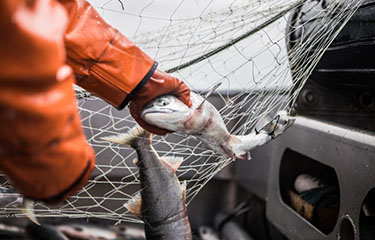The Alaska Department of Fish and Game’s 2024 Bristol Bay sockeye salmon forecast is once again calling for a smaller run than the year prior.
ADF&G is predicting a run in Bristol Bay of 39 million sockeye, down from the 54.5 million run in 2023.
The prediction would equivalate to a harvest of 26.1 million fish; in 2023, around 40.6 million sockeye were harvested commercially. If the prediction holds true, the harvest size would be 39 percent less than the 10-year harvest average of 40.7 million.
ADF&G predicted a run of 49.7 million sockeye in Bristol Bay last year, and the state agency acknowledged its preseason forecasts have under-forecast the actual run by 15 percent on average since 2001. Its forecast range for 2024 is 24.89 million to 53.12 million fish, with an 80 percent confidence level.
Inside of Bristol Bay, ADF&G predicted the Naknek-Kvichak run at 15.40 million, with a harvest of 8.06 million sockeye; the Nushagak run at 12.42 million, with a harvest of 8.29 million; the Egegik run at 5.7 million, with a harvest of 4.44 million; the Ugashik run at 4.78 million, with a harvest of 3.69 million; and the Togiak run at 70,000 sockeye, with a harvest of 52,000 fish.
In 2023, the Naknek-Kvichak catch was 13.1 million; the Egegik catch was 12.7 million; the Nushagak catch was 12 million; the Ugashik catch was 2.3 million; and the Togiak catch was 443,000. Total escapement neared 14 million sockeye.
In September, the University of Washington’s Fisheries Research Institute (FRI) estimated a run of 38.9 million sockeye across the bay, with a total harvest of 26.4 million sockeye. The forecast is calling for an average fish weight of 5.5 pounds, which would result in a harvest of 145.1 million pounds of salmon. An updated UW-FRI Preseason Forecast will be released later in November.
ADF&G reported the ex-vessel value of all salmon caught in Bristol Bay in 2023 was USD 117.4 million (EUR 109.5 million), 37 percent below the 20-year average of USD 187.6 million (EUR 174.9 million). Prices were estimated using fish ticket weight and price paid for each species, based on the major buyers’ base price and not including future price adjustments for icing, bleeding, floating, or production bonuses.
In a recent update, the Alaska Seafood Marketing Institute said the Alaska seafood industry “is facing extraordinary market challenges.”
“A convergence of domestic and international circumstances has created hardship for everyone in our industry,” it said. “Although Alaska’s fishermen produce more than 60 percent of America’s wild-caught seafood, Alaska seafood competes in a global market. By value, two-thirds of Alaska’s catch is exported. By weight, 80 percent is exported. We’re the 15th largest global seafood exporter (by value) and we harvest less than 10 percent of the global salmon supply. In short, Alaska seafood is a significant part of the domestic and international seafood markets, but we are subject to numerous geopolitical, trade inequity, and economic factors beyond our control.”
ASMI said the market downturn had impacted salmon, Alaska pollock, and sablefish sales, affecting ...
Photo courtesy of Bristol Bay Regional Seafood Development Association








